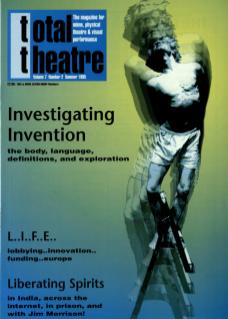When Augusto Boal flew into Britain earlier this year his stay drew wide media and practitioner attention.
When Purna Chandra Rao, one of India's most important theatre directors, was in Britain over Easter speaking at a conference in Exeter, nobody stirred. Surprising really, as he embodies all the right ingredients for a great Guardian feature: middle-class, rejects sanctioned career path to study alternative theatre, creates radical, anti-government plays with some of the poorest people in India, plays about illiteracy, government destruction of Tribal land and culture, starvation amongst Weavers, Women's rights, etc. Left-wing, committed, ‘third world’ and unknown – all highly suitable Guardian stuff! And yet, total silence.
So, who is this man?
He is the creator of Victim's Theatre in India, a style which pays lip-service to Boal's Theatre of the Oppressed and Eugenio Barba's Third Theatre (both of whom he has been in dialogue and studied with over the years). It has taken thirteen years of experimentation to develop his methodology, which includes a lot of surprising discoveries about Indian art and culture, the oppression under which it suffers, and many frustrations.
He found mainstream Indian culture served only the middle and upper classes, high-jacked by Western structure: realism, text and form were everything. At best it marginalised ethnic cultures and at worst tried to destroy them. He accidentally saw a performance by the radical Indian director, Badalda Sicar, who had trained with Grotowski, and used his methods of stripping away theatre paraphernalia as a vehicle for externalisation, trying to create an alternative theatre consciously aimed at the people and their issues. However, his audience was still essentially middle class.
Purna used these tools and adopted some of Brecht's ‘alienation’ techniques and took them into the street. Educated friends found his work too difficult and criticised it for its lack of form (how many times have we heard that one!). However, the working class rural poor accepted it because it was close to their own complex indigenous art forms: non-realism, stylisation and alienation – the aesthetics of the grassroots. The urban educated had lost their sensitivity to art appreciation because of conditioning of the West.
‘Our rural people are really healthy enough even in their sense of aesthetics which helps them feel at home with the ten-headed and hundred-handed gods and demons of the Indian pantheon... Abstract forms, patterns and designs can be kept as decorations in their homes and surroundings. That's why even in theatre our people don't need a cardboard set – realism created on the stage to depict particular settings or an atmosphere. Instead we depend on “mime” which originated from the concept of “empty space'”... trusting the power of the human body and the imagination of the human mind alone to depict the entire universe from the imagination of the audience. Our theatre does not believe in creating a "holy” distance between the actors and the audience... Great treatises have been written centuries back in India on body abstractions and about the construction of alternative meaning through the body movements as a means of communication. The urban educated have lost this.’
So what is Victim's Theatre?
Purna discovered that the illiterates were better at improvising than the educated actors he was working with, as long as they were characters within their personal experiences (the differences were too great between the urban poor and the rural poor for them to be able to depict each other). There was great suspicion amongst the illiterates towards the educated, due to the corruption and their exploitation by educated people.
To make a play with a community Purna first researches an issue, and finds the visible as well as the invisible (usually more harmful) oppression, before approaching a group. He integrates with the community, becomes friends especially with the more ‘active’ members, before raising the idea of making a play. Once that has been accepted he finds his actors, replacing their daily wage for as long as the tour happens. He then trains them, sixteen hours a day for 40-50 days through improvising. Because they are illiterate everything is done in the ‘oral tradition’, ‘mouth to mouth, body to body’, offering them lines and structures for them to change into their own dialect. Scripting is done purely for Purna's own benefit. Touring usually lasts 4-6 months, within the state of Andra Pradesh (about the size of Germany), performing only to communities similar to their own. After the show a discussion is engendered, the actors have been ‘educated, motivated and politicised’ during the production workshop, and this is duplicated to the audience. Purna says: ‘This holy union of theatre trinity [character, actor and audience] can be transcended into joint political action.’ Once the first couple of shows are over, they are self-sufficient. Purna leaves the company to start another project.
It is ironic that although much of his work criticises the government, he has been adopted by them and has been given funding for education projects in areas in which they have failed: a total literacy campaign and family planning for Muslim women. This had to change because it was impossible for Muslim women to come forward, they are still traditionally seen as the property of their husbands, and in purdah. Instead he created a show about a woman's right over her own body and performed it in Urdu, the Muslim language and dialect.
He is a catalyst, ‘an outsider but a real friend of the victimised community’. He is an idealist, aiming to empower the victims to handle and change their oppression. In reality he recognises that he can only hope to create discussion, change is a long way off.


